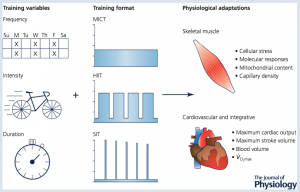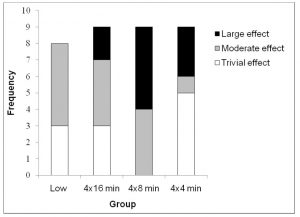
Interval exercise typically involves repeated bouts of intense exercise followed by short periods of recovery. This method is commonly divided into high-intensity interval training (HIIT; ‘near maximal’ efforts of 85-95% max heart rate) and sprint interval training (SIT; ‘supramaximal’ all-out efforts). Both forms of interval training induce similar adaptations to moderate-intensity endurance training such as increased aerobic capacity (VO2max) and mitochondrial content.
But what exactly is the role of intensity on the beneficial adaptations to aerobic capacity, and how intense do the intervals need to be? These are questions that senior researchers at McMaster University in Canada set out to answer in a paper reviewing the state of the art in our understanding.
How does interval training work?
Improvements in aerobic capacity come from two main sources:
- Increased muscle mitochondria content and capillary density
- Increased maximal stroke volume and cardiac output from the heart, combined with increased blood volume
Increased mitochondria density of the muscle not only allows higher aerobic capacity, but allows proportionally more fat to be used as fuel. This is good news also for lactate production allowing athletes to exercise for longer at higher % of their VO2max.
This mitochondrial content responds rapidly to training, and a single session is enough to activate increases. This activation stops after about 5 days of training at the same intensity, however if the intensity is increased it continues to rise for several weeks. There is also good evidence that higher intensities produce greater signals (mRNA for PGC-1a if you’re really interested) to create more mitochondria than lower intensities.
The authors also carried out studies to show that the on-off intermittent nature of interval training increases the adaptations compared to continuous workouts. They have demonstrated that three weekly sessions of Sprint Interval Training (1 min SIT per session) produced similar increases in signalling chemicals to 150 mins of weekly steady state exercise (that’s 98% off for the bargain hunters amongst you).
Higher exercise intensities also require more muscle fiber types to be recruited. Whereas moderate intensity exercise can rely almost exclusively on type I (red) muscle fibers, high intensities are needed to increase the mitochondrial content of type II (white) fibers.
With respect to the capillary density of the muscle, there is no clear evidence from research that exercise intensity rather than volume affects the relatively long timescale over which this increases.
A key measure of aerobic capacity is of course VO2max, and several studies over the past 25 years have concluded that HIT is more effective in increasing VO2max than the same amount of work performed in medium intensity training, both in healthy and unfit people.
These authors report that duration and frequency of interval training have much less impact than intensity, but still we need guidance on what structures of training do have the biggest bang per buck. Renowned exercise physiologist Stephen Seiler has looked at this in detail in skiers, runners and cyclists, and concluded that 8 min intervals produce bigger fitness gains in more athletes:

Seiler S, Jøranson K, Olessen BV, Hetlelid KJ. Adaptations to Aerobic Interval Training: Interactive Effects of Exercise Intensity And Total Work Duration. Scand. J. Med Sci Sports 23, 74-83, 2013.
Recommendations
Dr Seiler also gives a useful prescription list for coaches and self coached athletes using HIIT:
- Work bout duration and total accumulated work duration are two critical variables in the prescription that push (or pull) athlete into desired intensity zone.
- Rest interval duration has less relative impact, once you get above 90 seconds rest, but adding work intensity to rest periods will bring down work bout intensity quickly (Fartlek training).
- Prescribe to athletes that they should maintain constant power throughout session, maximal session effort.
- Let heart rate vary within the parameters of the prescription, do not use heart rate recovery to determine rest duration, just fix the rest duration at about 120 seconds.
- HIT intensity vs accumulated duration? – lower intensity and higher AWD gives equal or greater gain for less “pain”!
This final point is an important one. Performing intervals is not usually regarded as ‘fun’, so it’s good to find a format that maximises the benefits whilst minimising the suffering!
As we have reported in a previous blog post performing HIT on good heart rate variability (HRV days), HIT zone on the ithlete Pro Training Guide, delivers consistently improved results, and also feels better than doing them when you are under recovered and fatigued.
References
Ref 1: J Physiol 595.9 (2017) pp 2915–2930 2915 SYMPOSIUM REVIEW
Physiological adaptations to interval training and the role of exercise intensity
Martin J. MacInnis and Martin J. Gibala
Department of Kinesiology, McMaster University, Hamilton, Ontario, Canada
Ref 2: Many short or a few long HIT work bouts – does the HIT prescription matter?
Ole Wåle and Andreas M. Pedersen Masters Research project, University of Agder Kristiansand, Norway (Supervisor Dr Stephen Seiler).

Can’t remember how many weeks Seilers study was ,maybe 6 weeks or so, but the cylcists were pretty sh…ged out by the end of it .My memories of intervals are they’re good fun initially then after a few weeks the wheels fall off .I do love reading interval hiit studies though .
Thanks for the comment Leo. Yes, I think it was 7 wks, and HIT sessions require considerable mental discipline – perhaps one of the reasons that doing them on high HRV days when you have greater reserves produces better results. We should also be able to use HRV to detect the wheels “falling off” ;-) Simon.
Apologize for my bias, but is HIIT not what it have always been, just another brick in the wall when building your foundation? Depending on who you are, then it must be used very sparingly and not the opposite way around. I “think” we in general have a tendency to overreact on some “data-points” in science, because we as human beings need this. We seek a stand-alone answer or a simplification a complex world of training often resulting in more confusement than understanding.
Basically we are looking for a stimulus and an adaption,, true? I really like the paper (which is not the same as to say it’s the truth) “Intervals, Threshold, and long slow distance: The role of Intensity and Duration in Endurance Training” by Stephen Seiler and Esben Tønnessen, sportscience 13, 32-53, 2009. I cannot sum it all up, but the paper says that long term development of performance is a combination of a large volume of training at lower intensities under 2-mM and HIIT must be used sparingly. Many conclusions can be drawn, but overall, then don’t take your training anywhere you don’t need to go in order to avoid premature stagnation. “The effects of HIT on physiology and performance are fairly rapid, but rapid plateau effects are seen as well”.
In the paper there’s a reference to the German 4.000-m Team Pursuit who made a World Record in OL 2000 with a basis of 94% total training volume at lower intensities and roughly did only 8 interval session at the track prior to the event??
Quoting from the original paper itself “The 4000-m team pursuit cycling world record: theoretical and practical aspects.”
“…before the 2000 Olympic games, the team performed only eight discipline-specific track units on six distinctive days.” …
But what about recreational athletes? Well, in general they benefit from polarized training and the advice here is not to fall into the “black hole” of training to hard because the lack of time. Train easy on easy days, and then just top it with some HIT. This is old news and have created tons of champions. Off course you can get away with more HIT if you are anaerobic strong. But again it all depends on the individual.
Another good story is about the former professionel soccer player Knut Anders Fostervold who went from a fairly good cyclist with LT power at 4,5w/kg to an Elite Cyclist with LT power at 5,2w/kg within 18 weeks of training after initiation with the Norwegian Olympic Center. You have to read it yourself, but all he did was a little bit of training manipulation! He replaced his weekly HIIT sessions 45 min. in total with only 5 min. of HIIT… and then added a lot of LSD to his weekly routine. He then went on to represent Norway in the World Championships Time Trial..
My personal view on this is that the institute in an intelligent way “just lowered” his anaerobic capacity in order to raise his aerobic capacity and by that created a better balance in his performance.
Enjoy /Michael
Hello Michael. Thanks for the extended comment. The appeal of HIIT of course lies in its potential ability to produce big gains in a short time. The downside is that it is actually very difficult to get the effort level just right across intervals in a session, and to have a high enough level of mental commitment. In my experience it is easier to manage that on days when you are well recovered (and have high – but not too high – HRV). If that is all that was needed, professional cyclists would not be performing 30+ hrs a week of training, a lot of which is LSD (MAF) as you say, and in my training is the foundation of fitness.
Hello Simon, Thanks for your quick response. I totally agree that HIIT produce big gains in a short time. I do also agree about the HRV observations. I have used it now for 2 years, and have actually become a lot more clever on my own training (and that is said after spending over 30 years on it!). Further more, I have spent the last 10 years of digging down into the area of watts and performance, and ACL, CTL, TSB and so on are all good metrics…. But they does not tell you anything like the HRV measurement does – that’s why I use it. That’s maybe also why for example a lot of the big soccer teams in Europe use it… but maybe that’s a secret??
My point with the extended comment was just to point out what really matters and that people must balance the informations from the science community in their minds.
So this: “lower intensity and higher AWD gives equal or greater gain for less “pain”!”
means that I can do more intervals at a lower intensity to get the same training benefit?
In short – yes. Prof Seiler found that 8min intervals produced larger gains in a larger number of people than shorter, more intensive intervals. I would expect this to be very applicable to your long course triathlon training.